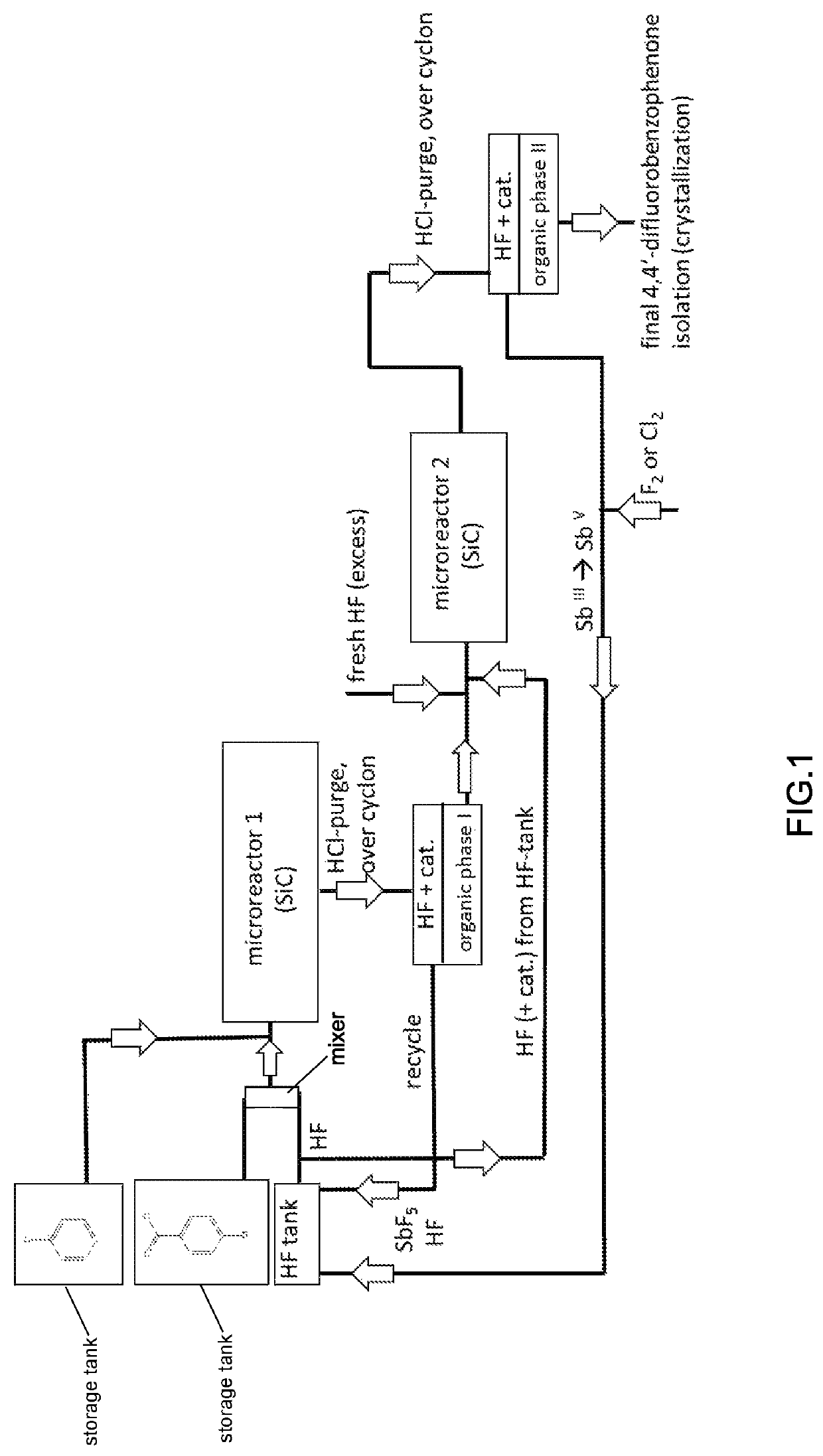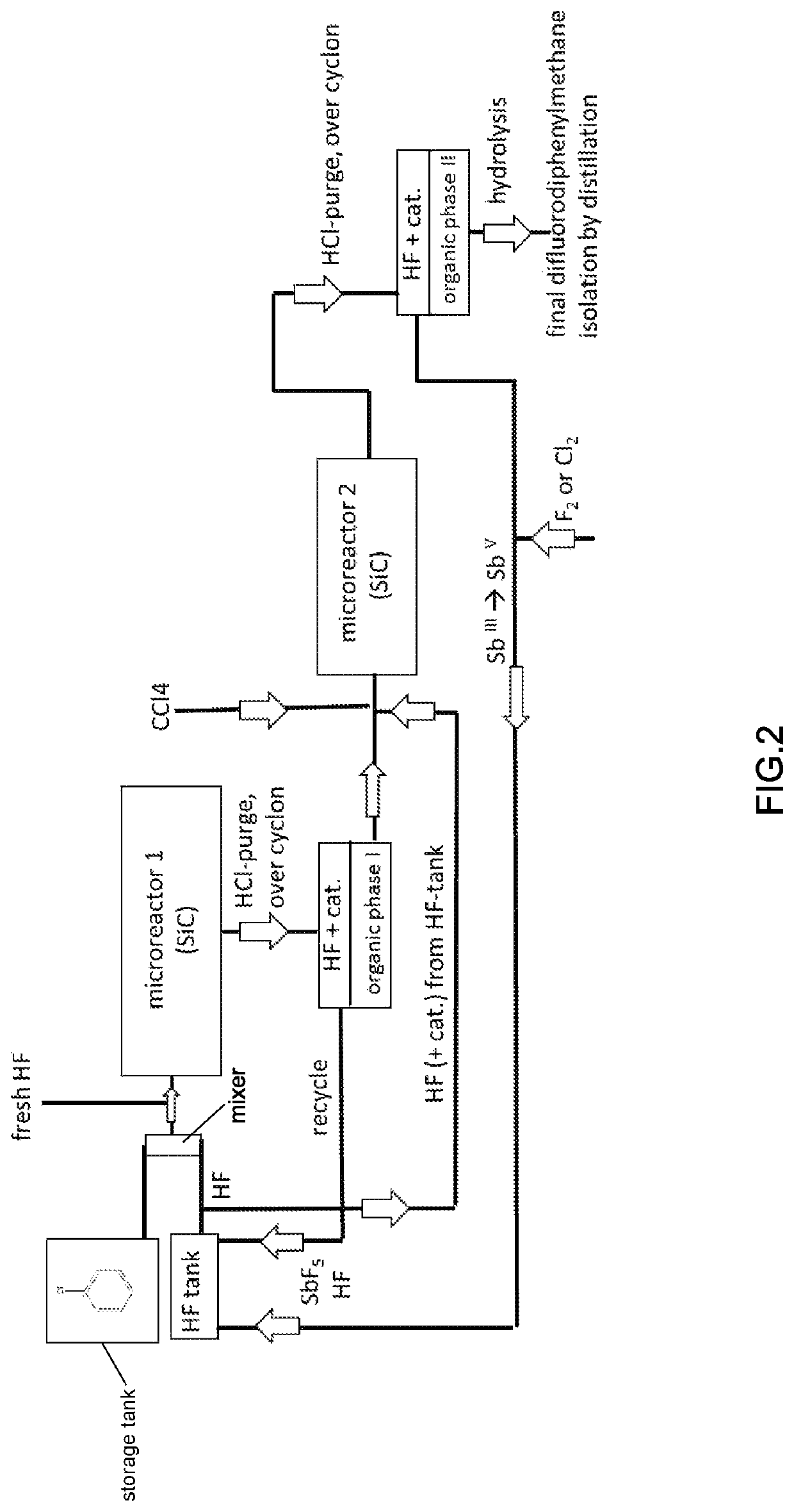Process for the manufacture of fluorinated benzenes and fluorinated benzophenones, and derivatives thereof
a technology of fluorinated benzenes and benzophenones, which is applied in the preparation of carbonyl compounds, physical/chemical process catalysts, halogenated hydrocarbon preparations, etc., can solve the problems of high glass transition temperature and melting point, affecting heat resistance and processing temperature, and affecting the dissolution rate of the compound, etc., to achieve easy production of starting materials and clean
- Summary
- Abstract
- Description
- Claims
- Application Information
AI Technical Summary
Benefits of technology
Problems solved by technology
Method used
Image
Examples
example 1
[0258]The synthesis flow in microreactors for 4,4′-difluorobenzophenone is shown in FIG. 1, and the reaction scheme and the conditions are given below.
[0259]4-Chlorobenzoylchloride is pre-mixed with the HF+catalyst mixture, preferably in a mixing system (e.g., a split and recombine system) to form at least partially chlorobenzoylfluoride and the corresponding SbHal6-complex which meets the chlorobenzene before the mixture enters microreactor 1 (material of construction is SiC).
[0260]The reaction is performed as a two-step procedure, comprising a fluorination step and a Friedel-Crafts reaction.
[0261]Chemistry in step 1 (Microreactor 1), Friedel-Crafts Acylation:
[0262]
[0263]If a settler of sufficient size is used, the HF-catalyst mixture will separate from organic material which mainly is the 4,4′-dichlorobenzophenone. In the next step the HF / catalyst mixture needs to be converted into a nucleophilic fluorinating agent by adding an excess of HF vs. the Sb molar ratio which should be g...
example 2
[0268]The CCl4-route according to the invention is shown in FIG. 2, and the reaction scheme is given below, The reaction conditions are as given in Example 1.
[0269]If the CCl4-route is used, it is advantageous first to prepare fluorobenzene and to do in a 2nd step the Friedel-Crafts with CCl4, like illustrated in the scheme below:
[0270]Chemistry in Step 1 (Microreactor 1), Fluorination Step:
[0271]
[0272]Chemistry in Step 2 (Microreactor 2), Friedel-Crafts Acylation:
[0273]
[0274]Step 3, Hydrolysis:
[0275]
example 3
[0276]The 4-chlorobenzylchlorid route according to the invention is shown in FIG. 3, and the reaction scheme is given below. The reaction conditions are as given in Example 1.
[0277]Chemistry in Step 1 (Microreactor 1), Friedel-Crafts Acylation:
[0278]
[0279]Chemistry in Step 2 (Microreactor 2), Fluorination Step:
PUM
| Property | Measurement | Unit |
|---|---|---|
| operating temperature | aaaaa | aaaaa |
| Young's modulus | aaaaa | aaaaa |
| Young's modulus | aaaaa | aaaaa |
Abstract
Description
Claims
Application Information
 Login to View More
Login to View More - R&D
- Intellectual Property
- Life Sciences
- Materials
- Tech Scout
- Unparalleled Data Quality
- Higher Quality Content
- 60% Fewer Hallucinations
Browse by: Latest US Patents, China's latest patents, Technical Efficacy Thesaurus, Application Domain, Technology Topic, Popular Technical Reports.
© 2025 PatSnap. All rights reserved.Legal|Privacy policy|Modern Slavery Act Transparency Statement|Sitemap|About US| Contact US: help@patsnap.com



